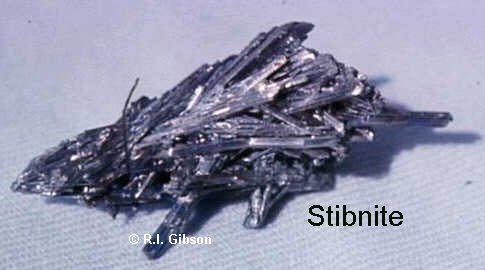
If chemical elements could win Oscars, antimony would get my vote for Best Supporting Actor. Its name comes from the Greek anti and monos, meaning "against being alone." And indeed, both in the ground and in industry, it does its best work in combination with other elements. It's an unsung metal, about as rare as silver, but while it doesn't demand the spotlight, it doesn't shrink from it, either. Actually, it doesn't shrink at all, which is one key to its success.
 The main ore of antimony is stibnite, and antimony sulfide. The ancient Egyptians and early Hindus ground up stibnite to make a dark eye shadow called kohl. Antimony itself wasn't identified as an element until around 1450, purportedly by an alchemist Benedictine monk, Basil Valentine. Valentine is now considered to be a fictional character, invented by a German author, and we're not certain who deserves the credit for isolating elemental antimony. Nicolas Lemery, a French chemist, wrote the first detailed report on the element in 1707. Early metallurgists learned that, while it wasn't much use on its own, adding it to other metals produced stronger, harder compounds that were more resistant to corrosion. (That's why your car's "lead" battery terminals are actually a lead-antimony alloy.) The main ore of antimony is stibnite, and antimony sulfide. The ancient Egyptians and early Hindus ground up stibnite to make a dark eye shadow called kohl. Antimony itself wasn't identified as an element until around 1450, purportedly by an alchemist Benedictine monk, Basil Valentine. Valentine is now considered to be a fictional character, invented by a German author, and we're not certain who deserves the credit for isolating elemental antimony. Nicolas Lemery, a French chemist, wrote the first detailed report on the element in 1707. Early metallurgists learned that, while it wasn't much use on its own, adding it to other metals produced stronger, harder compounds that were more resistant to corrosion. (That's why your car's "lead" battery terminals are actually a lead-antimony alloy.)
Stranger still, they discovered, antimony expands when it solidifies, just as water does when it freezes. Its crystals, like those of ice, contain an unusual amount of empty space - three percent more than do free-swimming molecules in molten antimony. As a result, antimony alloys resist contraction when they harden. This unusual combination of shrink-resistance and toughness means they can be cast with fine edges. An alloy of lead, tin, antimony, and a little copper was the metal of choice for casting movable type for printing from the time of Gutenberg until modern printing techniques superseded "hot metal" a few years ago.
Nowadays more than half of all the antimony produced is used as a flame retardant in plastics, textiles, rubber, and adhesives. First applied to tents and vehicle coverings during World War II, the fireproofing compound antimony trichloride saved the lives of many American GIs. In a fire, antimony and chlorine recombine to form unstable compounds that suck oxygen out of the air, smothering the flames. Ironically, antimony (without chlorine) also crops up in chemicals used to start fires. Antimony sulfide has weak chemical bonds that cause it to melt and catch fire at relatively low temperatures. For that reason it's a key combustion-supporting ingredient in tracer bullets, smoke screens, "glitter effect" fireworks, and the striking surface of safety matches.
About three-quarters of the world's antimony production comes from stibnite mines in Hunan Province of China. Raw stibnite is handsome stuff: bladed clusters of long silvery crystals streaked with long grooves, or striations. The striations look like scratches, but they are actually narrow crystal faces. The finest stibnite crystals come from Shikoku Island, Japan, where magnificent striated blades, some the size of fence posts, crystallized out of hot solutions flowing through cracks in 100-million-year-old rocks. Other fine radiating sprays of crystals are found in China, Romania, and Russia.
The United States has only one antimony mine, in the metal-rich Coeur d'Alene District of northern Idaho. There the ore is not stibnite but tetrahedrite, a rare silver-copper-antimony sulfide that yields antimony as a byproduct of refining other, flashier metals. That seems to be antimony's lot in life: always a sidekick, never a star.
Back to What Things Are Made Of • Blog - where you can ask questions and comment
|